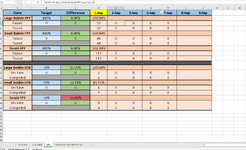Basically, I want autofill to skip reference columns at a static rate.
I have the formula "=SUM('FPY Data'!K5:K54)-SUM('FPY Data'!L5:L54)" in column E. When I drag autofill across column F is "=SUM('FPY Data'!L5:L54)-SUM('FPY Data'!M5:M54)" but I want it to be "=SUM('FPY Data'!R5:R54)-SUM('FPY Data'!S5:S54)"
I tried filling in a few rows manually and then selecting them all to autofill hoping that it would pick up the pattern, but that did not work. I also messed around with the Offset function, but it would have to increase the offset by 6 columns each time.
If it's easier to just make a macro in VBA to do this, I would give it a try.
I have the formula "=SUM('FPY Data'!K5:K54)-SUM('FPY Data'!L5:L54)" in column E. When I drag autofill across column F is "=SUM('FPY Data'!L5:L54)-SUM('FPY Data'!M5:M54)" but I want it to be "=SUM('FPY Data'!R5:R54)-SUM('FPY Data'!S5:S54)"
I tried filling in a few rows manually and then selecting them all to autofill hoping that it would pick up the pattern, but that did not work. I also messed around with the Offset function, but it would have to increase the offset by 6 columns each time.
If it's easier to just make a macro in VBA to do this, I would give it a try.






